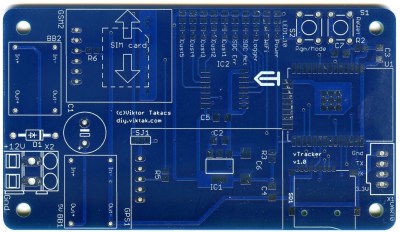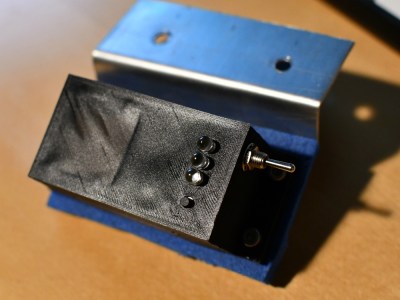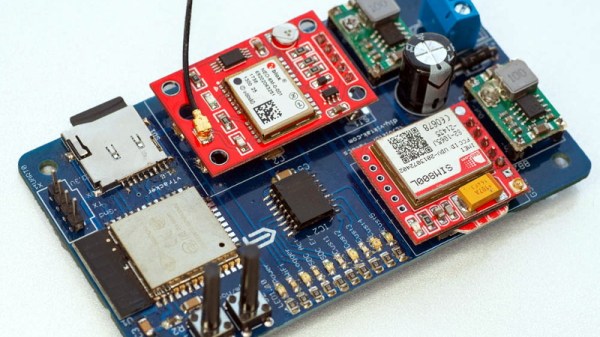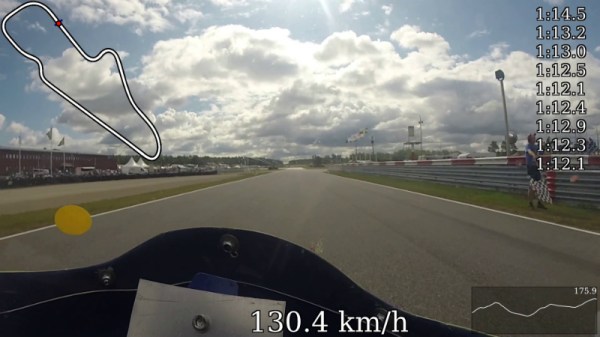As [Matt Stele] prepared to bike a local 300-mile (~480km) race in addition to training, he had to prepare for food. A full day of riding was ahead on gravel trails, and one of the best options for him was Casey’s General Store pizza. However, as it was a race, other riders were much faster than him. So, all the hot slices were gone when he arrived. With the help of a serverless GPS tracker, some cloud lambdas, and some good old-fashioned web scraping, [Matt] had a system that could order him a fresh pizza at the precise moment he needed. Continue reading “Ordering Pizza While Racing”
gps tracker13 Articles
Kinefox Tracks Wildlife For A Lifetime
Radio trackers have become an important part of studying the movements of wildlife, but keeping one running for the life of an animal has been challenging. Researchers have now developed a way to let wildlife recharge trackers via their movements.
With trackers limited to less than 5% of an animal’s total mass to prevent limitations to the their movement, it can be especially difficult to fit trackers with an appropriately-sized battery pack to last a lifetime. Some trackers have been fitted with solar cells, but besides issues with robustness, many animals are nocturnal or live in dimly-lit spaces making this solution less than ideal. Previous experiments with kinetically-charged trackers were quite bulky.
The Kinefox wildlife tracking system uses an 18 g, Kinetron MSG32 kinetic energy harvesting mechanism to power the GPS and accelerometer. Similar to the mechanical systems found in automatic winding watches, this energy harvester uses a pendulum glued to a ferromagnetic ring which generates power as it moves around a copper coil. Power is stored in a Li-ion capacitor rated for 20,000 charge/discharge cycles to ensure better longevity than would be afforded by a Li-ion battery. Data is transmitted via Sigfox to a cloud-based database for easy access.
If you want to build one to track your own pets, the files and BOM are available on GitHub. We’ve featured other animal trackers before for cats and dogs which are probably also applicable to bison.
Handmade GPS Tracker Keeps An Eye On Adventurous Cats
One of the most convenient things about having cats is their independent lifestyle: most are happy to enjoy themselves outside all day, only coming back home when it’s time for dinner and a nap. What your cat gets up to during the day remains a mystery, unless you fit it with a GPS collar. When [Sahas Chitlange] went searching for a GPS tracker for his beloved Pumpkin, he found that none were exactly to his liking: too slow, too big, or simply unreliable. This led him to design and build his own, called Find My Cat.
Continue reading “Handmade GPS Tracker Keeps An Eye On Adventurous Cats”
Giving Your Pets A Digital Squeak
A pet tracker has a particularly grueling set of requirements: small, light, rugged, incredibly long battery life, safe for the pet, and cheap. [Mihai Cuciuc] was looking at the options and wasn’t thrilled with any of them. So as any hacker would, he rolled his own, dubbed Squeak.
It uses an RN2483 module as it is a LoRAWAN module with publically available firmware from Microchip itself. This means [Mihai] could add his code and keep the modem code without having to reverse engineer everything or add a second microcontroller. In addition to the modem, there’s a GPS unit connected via UART. The clever part is the dual voltage regulators — the one powering the GPS is enabled or disabled by the RN2483. In addition, the RAM V_BACKUP line is always powered, which means the RN2483 can power up the GPS and let it get a quick fix (thanks to the RAM backup line).
To maximize the chances of a packet making it through, he made them only have the bare essentials. There are return packets to change the tracker’s mode (such as uplink interval or how often to capture GPS). With some cloud support, [Mihai] created infrastructure to capture the packets and relay them to Telegram. He can request the last location, receive updates, and change modes.
We’ve got you covered if you’re interested in tracking some of your dog’s other habits.
Keep An Eye On Your Bike With This DIY GPS Tracker
Owning a bike and commuting on it regularly is a great way to end up with your bike getting stolen, unfortunately. It can be a frustrating experience, and it can be particularly difficult to track a bike down once it’s vanished. [Johan] didn’t want to be caught out, however, and thus built a compact GPS tracker to give himself a fighting chance to hang on to his ride.
It’s built around the Arduino MKR GSM, a special Arduino built specifically for Internet of Things project. Sporting a cellular modem onboard, it can communicate with GSM and 3G networks out of the box. It’s paired with the MKR GPS shield to determine the bike’s location, and a ADXL345 3-axis accelerometer to detect movement. When unauthorised movement is detected, the tracker can send out text messages via cellular connection in order to help the owner track down the missing bike.
The tracker goes for a stealth installation, giving up the deterrent factor in order to lessen the chance of a thief damaging or disabling the hardware. It’s a project that should give [Johan] some peace of mind, though of course knowing where the bike is, and getting it back, are two different things entirely. We’ve seen creative techniques to build trackers for cats, too. It used to be the case that such “tracking devices” were the preserve of movies alone, but no longer. If you’ve got your own build, be sure to let us know on the tipline!
Open Hardware GPS Tracker Works On Your Terms
These days, there’s plenty of options if you want to get a GPS tracker for your vehicle. Unfortunately, they come with the sort of baggage that’s becoming increasingly common with consumer tech: subscription fees, third-party snooping, and a sneaking suspicion that you’re more commodity than customer. So [Viktor Takacs] decided to take things into his own hands and create an open GPS tracker designed for privacy minded hackers.
As [Viktor] didn’t want to reinvent the wheel, his design leverages several off-the-shelf modules. The core of the tracker is the ESP32, which gives him plenty of computational power while still keeping energy consumption within reasonable levels. There’s also a NEO-6M GPS receiver which works at the same 3.3 V level as the ESP32, allowing the microcontroller to read the NMEA sentences without a level shifter. He decided to go with the low-cost SIM800L GSM modem, but as it only works on 2G networks, provisions have been made in the board design to swap it out for a more modern module should you desire.
 For the code to glue it all together, [Viktor] pulled in nearly a dozen open source libraries to create a feature-complete firmware that uses MQTT to create a database of location data on his personal server. From there the data is plugged into Home Assistant and visualized with Grafana. This is enough to deliver core functionality, but he says that more custom software components as well as a deep-dive into the security implications of the system is coming in the near future.
For the code to glue it all together, [Viktor] pulled in nearly a dozen open source libraries to create a feature-complete firmware that uses MQTT to create a database of location data on his personal server. From there the data is plugged into Home Assistant and visualized with Grafana. This is enough to deliver core functionality, but he says that more custom software components as well as a deep-dive into the security implications of the system is coming in the near future.
We’ve seen custom built GPS trackers before, as generally speaking, it doesn’t take a whole lot to spin up your own solution. But we think the polish that [Viktor] has put on this project takes it to the next level, and ranks it up there among some of the most impressive bespoke tracking solutions we’ve seen over the years.
GPS Overlays Give Real Life Racing A Video Game Feel
Racing is certainly exciting for the person rocketing around the track fast enough to get the speedometer into the triple digits, and tends to be a decent thrill for the spectators if they’ve got good seats. But if you’re just watching raw race videos on YouTube from the comfort of your office chair it can be a bit difficult to appreciate. There’s a lack of context for the viewer, and it can be hard to get the same sense of speed and position that you’d have if you saw the event first hand.
 In an effort to give his father’s racing videos a bit more punch, [DusteD] came up with a clever way of adding video game style overlays to the recordings. The system provides real-time speed, lap times, and even a miniature representation of the track complete with a marker to show where the action is taking place. The end result is that recordings of Dad’s exploits on the track could pass as gameplay footage from Gran Turismo (we know GT doesn’t have motorcycles, but you get the idea).
In an effort to give his father’s racing videos a bit more punch, [DusteD] came up with a clever way of adding video game style overlays to the recordings. The system provides real-time speed, lap times, and even a miniature representation of the track complete with a marker to show where the action is taking place. The end result is that recordings of Dad’s exploits on the track could pass as gameplay footage from Gran Turismo (we know GT doesn’t have motorcycles, but you get the idea).
The first part of the system is the tracker itself, which consists of a GPS receiver, an Arduino Pro Micro, and an SD card module. [DusteD] powers the device with two 18650 cells in parallel, and a DC-DC boost converter to step it up to 5V. Everything is contained in a 3D printed enclosure that he designed in OpenSCAD, with the only external elements being a toggle switch, a momentary switch, and most critically, a set of LEDs.
These LEDs play into the second part of the system, the software. The blinking LEDs are positioned so they’ll get picked up by the camera, which is then used to help synchronize the data stored on the SD card with the video. [DusteD] came up with some software that will take the speed and position information from the card, and turn it into PNG files with transparent backgrounds. These are then placed on top of the video with the help of FFmpeg. It takes a little adjustment to get everything lined up properly, but as the video after the break shows the end result is very impressive.
This build reminds us of the Raspberry Pi powered GPS helmet camera we featured a few years back, and it’s interesting to see how the two projects achieved what’s essentially the same goal in different ways.
Continue reading “GPS Overlays Give Real Life Racing A Video Game Feel”

















